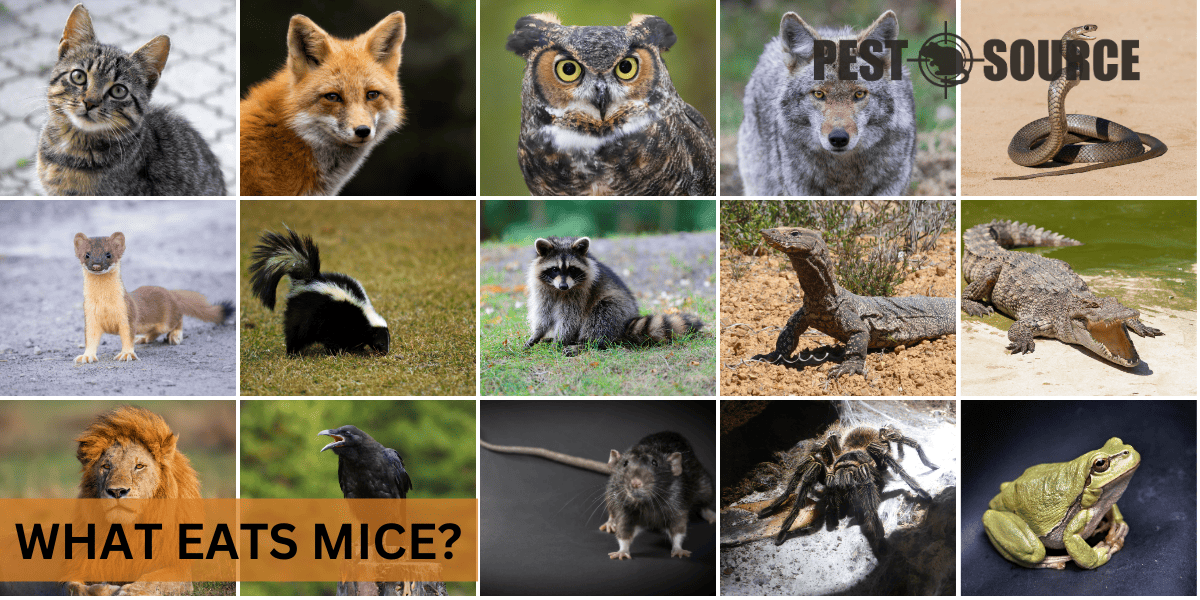Mice are preyed upon by various animals, including cats, snakes, birds of prey, and certain insects. Understanding the natural predators of mice can provide insights into ecological pest control and the role these rodents play in the food chain.
POINTS
- Mice, due to their high reproduction rate and size, serve as a key food source for a diverse range of predators, thereby playing a major role in sustaining ecosystems.
- Predators ranging from mammals like cats, dogs, and weasels to reptiles like snakes and lizards to avian predators like eagles, owls, and hawks form the natural pest control against mice.
- Even humans, in certain cultures, consume mice, demonstrating our shared food sources with other mammalian and reptilian species.
- Mice, despite being commonly perceived as prey, can themselves act as predators, feeding on a variety of plant material, insects, and worms.
- Mice have developed various defensive strategies like keen hearing, nocturnal habits, quick reflexes, burrowing, and rapid reproduction rate to survive in the presence of their diverse array of predators.
Understanding the Ecological Role of Mice as Prey
What is the significance of mice in the food chain?
Mice sit squarely in the middle of the food chain, bridging the gap between primary producers – like plants and grains – and a wide variety of secondary consumers. Their high reproduction rate and the fact that they’re a well-suited size for many predators, makes them a convenient, nutritional snack. Furthermore, as nocturnal creatures, mice serve as the nighttime meal for species that either hunt or forage when the sun goes down.
What makes mice prey to a diverse variety of species in the ecosystem?
Owing to their size, abundance, and the fact that they’re easy to catch, mice often find themselves on the menu for a host of different animals. Predators spanning from common household pets like cats, to raptorial birds, reptiles, and other mammals feed on mice, making their role in the food chain vital to sustaining a large variety of species.
How do mouse predators affect the control of these rodents’ population?
Predators that hunt mice provide a natural method of pest control, keeping mouse populations from overrunning ecosystems and human settlements. This control isn’t only about the numbers. Predators can influence the behavior and range of mice, aiding in the prevention of damage to human infrastructure and crops.
Felidae (Cat Family)
The Felidae family – or in simpler terms, the cat family – are well-known mouse predators. They range from the domestic cats prowling your neighborhoods to larger wild cats in less suburban environments.
Domestic Cats
A common addition to households, domestic cats are notorious for their hunting prowess. Whether they are needed for pest control or not, they regularly display their ‘gifts’ to the horror or delight of their pet parents.
Wild Cats (bobcats, lynxes)
While wild cats such as bobcats and lynxes have larger prey like rabbits and hares, mice form an integral part of their diet. They make for an easier quarry and ensure food availability when larger prey is scarce.
Big cats (lions, tigers, jaguars)
Though mice are not a significant portion of their diet, they are not exempt from the menu. Big cats will eat mice when given the chance or when their regular meaty meals are hard to come by.
Despite the magnitude, the hunting prowess of the cat family has always been admired and feared, making them an effective natural solution for mouse control. But remember, cats are natural hunters and pest control shouldn’t be their sole purpose. They need care, affection, and a balanced diet for their well-being.
Canidae (Dog Family)
Mice also fall prey to the Canidae family – the dog family. This group includes dogs as well as wild canine species.
Domestic Dogs
Some breeds of domestic dogs — terrier breeds in particular — have a history intertwined with pest control. Known for their sharp hunting instinct, these dogs were bred specifically to control weasel, fox, and rat populations, and so will not hesitate to eat mice when the opportunity arises.
Foxes
Foxes, like the common red fox, are opportunistic eaters and mice make an easy meal for them. Mice form a significant part of their diet, especially in regions where larger prey is hard to come by.
Coyotes
With their diet determined more by availability than preference, coyotes, too, will not turn down a mouse snack. Their omnivorous diet includes small mammals like mice, making them another natural pest controller.
Jackals
The diet of a jackal is much like that of a coyote or fox. Jackals also qualify as effective mouse predators due to their omnivorous diet and hunting capabilities. Mice and other small mammals are a considerable part of their meals.
Dingoes
Dingoes, the wild dogs from Down Under, also feed on mice. These top-niche predators have diverse diets, ranging from kangaroos and sheep to small creatures like mice.
Wolves
Rounding off the canine predators of mice are wolves. As the apex predators in multiple ecosystems around the world, mice may not be their first choice. Still, when hunting for larger game is challenging or unfruitful, every bit helps — including mice.
Accipitridae and Strigidae (Birds of Prey)
The Accipitridae and Strigidae families, comprising primarily of various species of owls, hawks, falcons, and eagles, have an integral role to play in maintaining the mice population.
Owls are silent hunters of the night. Their keen hearing ability combined with the ability to fly without making a sound makes them a formidable predator of mice. A barn owl family, for instance, can control a dozen or more mice every night, making them valuable allies for humans in agricultural areas.
Hawks, falcons, and eagles are no different. Their superior eyesight, sharp talons, and incredible hunting skills make them efficient mouse predators. The belief that only owls are mouse predators while others stick to larger prey is a common misconception. All these birds of prey are adaptable hunters that will regulate their diet based on the availability of food.
Other Birds
Beyond predators that soar above, there are ground-dwelling birds that contribute to controlling the mouse population. These include:
Blue Jay
Although smaller than the birds of prey, the blue jay is notorious for its aggressive behavior. They are omnivorous with a diet that comprises insects, seeds, berries, and small creatures, including mice.
Heron
Generally known for their fish-catching abilities, herons are not against having a mouse for a meal. They are opportunistic feeders and tend to eat what is available and easy to catch, including mice if they happen to come across them.
Shrikes
Often dubbed as “butcher birds”, shrikes hunt mice by paralyzing them with a bite to the neck and then swallowing them whole after some preparatory pecks.
Crows and Ravens (Corvidae family)
Considered among the smartest of birds, crows and ravens display outstanding adaptability when it comes to their diet. They consume a wide variety of foods including grains, berries, insects, carrion, and small animals like mice.
Serpentes (Snakes)
Snakes are well-known predators of mice across the globe. Their hinged jaws allow them to swallow creatures larger than their head, making mice an ideal-sized meal. Pythons, corn snakes, black rat snakes, eastern rat snakes, and rattlesnakes all form part of this group of mouse predators.
While snakes can strike fear into many hearts, when it comes to pest control, they are a valuable ally. Given their environment-friendly, non-toxic, rodent-controlling capabilities, snakes warrant due respect and understanding to co-exist peacefully with them.
Mustelidae (Weasel Family)
This diverse family that includes weasels, ferrets, minks, mongooses, and stoats are quite proficient when it comes to hunting mice. Known for their agility and quickness, these hunters quite often stalk, capture, and consume small rodents.
Weasels, Ferrets, and Stoats
Weasels and their close relative, the ferrets, are well adapted to hunting mice due to their slender bodies that allow them to enter burrows and other narrow spaces where mice hide. Similarly, stoats have these adaptations along with a tenacious nature that makes them brave enough to take on prey larger than themselves.
Minks and Mongooses
Minks have a varied diet comprising mammals, fish, and birds, and can add mice to their diet without fuss when necessary. Mongooses, famous for their snake-killing abilities, also include small mammals like mice as part of their regular diet, making them another natural form of pest control.
Mephitidae (Skunks)
You might not think of skunks as predators of mice, but these mammals are very opportunistic eaters. Their diet incorporates a variety of foods ranging from insects, larvae, earthworms to small mammals like mice when the opportunity presents itself.
Procyonidae (Raccoons)
Similar to skunks, raccoons fall under the category of opportunistic eaters. Their manipulative paws and adaptability allow them to exploit various food sources. Although they primarily hunt for invertebrates and plant foods, they can switch to hunting small animals such as mice when available.
Meles (Badger Family)
Badgers are omnivorous and aren’t particularly fussy when it comes to their menu. While worms and grubs make up the majority of their diet, they can hunt small mammals, including mice, attributing to their natural pest control capabilities.
Badger’s underground hunting strategy can prove particularly effective against burrowing mice, making them a notable predator of these small rodents.
Squamata (Lizards and other Reptiles)
Reptiles like lizards also consume mice to meet their dietary needs. They’re not specialists like some snakes and birds of prey but are more generalist predators, happily taking whatever they can catch.
Certain large sizes of lizards, like monitor lizards, alligator lizards, skinks, bearded dragons, and iguanas, are capable of taking down mice. They rely on their sharp teeth and strong jaws to seize and swallow mice whole. As such, they play a crucial role in nature’s pest control system.
Crocodylia (Crocodiles)
Crocodiles have an extremely broad diet, owing to their habitat in rivers and lakes. While their diet primarily consists of fish and larger mammal species, they are opportunistic hunters and wouldn’t hesitate to grab a meandering mouse drinking from the water’s edge. With sharp teeth and a powerful grip, they have the equipage to catch and consume mice.
Amphibia (Amphibians)
We mustn’t forget about our amphibious friends when it comes to mouse predators. Frogs and toads, despite their seemingly harmless disposition, are avid bug-eaters and will not shy away from a small rodent such as a mouse. Their long, sticky tongues work excellently in capturing prey, providing a round-the-clock pest control service in your garden.
Arachnida and Insecta (Spiders and Insects)
Mice have predators in nearly every class of animals, right down to arachnids and insects. Large spiders such as the huntsman spider and the Goliath birdeater, have been noted to take down mice. Praying mantises, although typically insectivores, have been known to take on prey much larger than themselves, including mice.
Rodentia (Rodents)
Although it seems counter-intuitive, larger rodents like rats have been known to prey on mice, especially in environments where food resources are limited. This cannibalistic tendency underscores the survival instinct in these animals, a potent reminder of the harsh realities of nature.
Hominidae (Humans)
Although dietary habits greatly vary across cultures, humans, too, eat rodents in certain places. A prime example of this is the use of mice in traditional health remedies in east Asia. Baby mouse wine, where the mice are fermented alongside the wine, is consumed in places like China and Korea.
In regions of Zambia and Malawi, dishes and skewers featuring mice are a common sight in local food markets. Despite our advanced socio-cultural evolution, we still share a food source with our mammalian and reptilian counterparts.
The Predation of Mice in Specific Environments
What eats mice and rats?
Various predators including but not limited to cats, dogs, birds of prey, snakes, weasels, and larger rodents like rats eat mice. The list of predators expands when we include opportunistic hunters like raccoons, skunks, foxes, and certain types of fish, frogs, and spiders.
What eats mice in the wild versus urban settings?
In wild settings, mice fall prey to a diverse number of predators such as snakes, birds of prey, foxes, and coyotes, among others.
In urban or suburban areas, domesticated animals like cats and certain dogs also prey on mice. Larger rats, an urban phenomenon, are also known to eat mice when food sources become scarce.
What would likely eat a mouse caught in a trap?
In addition to the noted mouse predators, scavengers are also likely to eat a mouse caught in a trap. This can include animals like raccoons, rats, and certain species of birds.
What eats dead mice?
Scavengers largely consume dead mice. These can include creatures like foxes, raccoons, vultures, eagles, and even beetles and certain flies. Apart from providing a meal, dead mice also help scavengers by limiting the spread of diseases by consuming the carcasses.
Predatory Behavior and Prey Selection
How do birds hunt for mice?
Birds of prey, including hawks, eagles, and owls, use their sharp talons and beaks to hunt for mice. They use their keen eyesight to spot prey even from a high altitude. Once they have located a target, they swoop down quickly and grab the mouse using their talons.
Predatory birds are known for their excellent hunting techniques. For instance, the owl uses its ability to fly silently in order to sneak up on potential prey, while a hawk might use the surrounding environment to its advantage to ambush unsuspecting mice.
What eats field mice?
Field mice have a similar list of predators to their house mouse counterparts. These include snakes, foxes, coyotes, dogs, cats, weasels, birds of prey, and even certain species of spiders.
Do all predators of mice eat every part of their prey?
No, not all predators eat every part of the mice they catch. Predators such as wolves might tear off the head and consume the entrails, leaving the rest for scavengers. Conversely, snakes consume their prey whole due to their body structure and digestive mechanism. Birds of prey tear their meal into manageable parts while some, like owls, swallow small prey whole and regurgitate the indigestible parts. Depending on the predator, different parts of a mouse might be consumed or discarded.
Mice as Predators
While mice are typically prey, they can be predators in certain contexts. Mice are omnivorous and can eat various types of food, including insects, worms, and a variety of plant material.
Defensive Strategies of Mice Against Predators
Despite being considered as easy prey, mice have developed various defensive strategies to survive in the wild. They are mainly nocturnal, an adaptation that helps them avoid many of their day-active predators.
Mice have a keen sense of hearing that allows them to detect predators before they can launch an attack. They have nimble bodies, allowing them to scamper away swiftly when they sense danger. Many are excellent burrowers, digging complex underground tunnels and nests that provide protection from most predators.
Lastly, mice are prolific breeders. Female mice can start reproducing at a very young age and have up to 10 litters a year. This fast reproduction rate can help a mouse population rebound quickly, even after a significant predation event.



